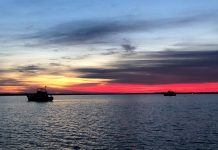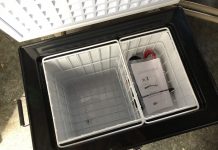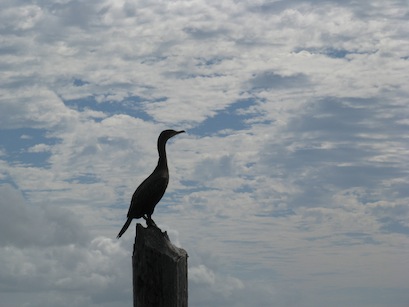Why does it seem like we’re always having to replace our batteries? Maybe because we’ve owned the boat almost 15 years and replaced them now 3 times? But when you read the specs online, it doesn’t really seem to matter whether you opt for gel cells, AGMs or flooded lead acid batteries, all of them have lifespans of somewhere between 3 – 8 years.
These are 4 1/2 years old. But life aboard a sailboat is hard on batteries – especially if you’re really out cruising. It’s literally impossible to charge them fully “out cruising” and this set of batteries endured our 157 night straight anchored out never going to a dock adventure. So, maybe it’s time.

While we were anchored out for a week just before the holidays, the batteries indicated 12.25 (basically a dead battery) in the morning – when they were only down about 30-50 amp hours. They should be FINE all the way down to 120 amp hours when the yellow “time to charge” light illuminates on our Link 10 monitor. David checked each battery — 5 of the 6 were showing 6.1-6.2 volts after overnight – one showed 4.8. So we knew we had one dead battery.
When we returned to the marina, David borrowed our boat electrician friend’s fancy diagnostic tool and we found that every battery said either “weak” or “bad”. Now what to do.
When we left the US to go cruising, we had 8D gel cell batteries. We found, at that time, we could not replace gel cells in the Western Caribbean when they were bad after 5 years. So in LaCeiba, Honduras, we converted to Trojan T105 flooded lead acid batteries because they were readily available.

We replaced them in Panama in 2009 and now we can either replace them again or convert to a different type of battery – preferably one that doesn’t require maintenance and watering. Despite our diligence in having a caretaker check the batteries monthly while we’re away, there have been times when we’ve come back to dry cells in the batteries – severely shortening battery life. 🙁
But after doing the research, and having most people recommend AGM’s, we found between the price difference – it would cost us approx $1000, plus installation if we couldn’t do it ourselves, to convert. PLUS the leading AGM manufacturer, Lifeline still says on it’s website that AGM’s must be recharged to 100% every time – here’s the link: LifeLine where it states: “Once you have selected and installed your battery bank (s), there are some simple tips to insure a long cycle-life. After you have discharged your batteries, be sure you fully recharge them.” We have a cruising buddy boat that was an electrician and was severely disappointed in only getting 3 years out of his AGM batteries – when he contacted LifeLine, he was told it was because he wasn’t 100% recharging them. Out cruising, it’s next to impossible to recharge to 100% even with our little Honda 2000 generator, let alone solar & wind.

So after checking pricing and comparing lifespan, we’ve decided to replace the Trojan T105’s. We found them for $91 each at a golf cart shop locally. The big catch is that everywhere these days requires you to bring in the old battery or they charge you … in this case $23 more per battery. So we lugged old batteries in and brought new Trojan T105’s home.

One other important consideration — make sure if your boat is knocked down or lays on its side that your batteries don’t become 62 lb (each) lethal missiles. If you look closely at the photo below, you can see the white bar that bolts down, holding our batteries in place. It’s not perfect, but it works. Don’t forget to make sure your batteries aren’t going anywhere!

Two important steps before we removed the batteries … first, we photographed exactly how all the connections went and then David drew himself a little diagram so he knows where to put the cables back. Sure saves alot of hassle when putting them back in!
Don’t forget to use the liquid electrical tape – black & red – to cover all the connections in an attempt to keep out the corrosion.
Voila! We’re $589 dollars poorer, but the house battery bank is good to go! We recently replaced the starter battery and checking the windlass battery shows that it’s still good, so no need to replace it.
One more unexpected project finished successfully!














Batteries can be cantankerous, touchy, and dangerous. It sounds like you are getting quite an education on them. A few comments from my school of hard knocks: First, I have not seen any overall advantage to gel cells. Yes they do not require liquid level maintenance (they are generally sealed to prevent tampering). Yes they are 30% to 50% more expensive. No they are not available everywhere. Yes they are much more sensitive to not being 100% charged every time. Given the plusses and minuses the choice has to be made based on individual needs. I presume you are using deep cycle batteries for your house battery bank. Deep cycle batteries are designed for use in electric powered equipment such as golf carts, fork lifts, and scissor lifts. They are designed to be pulled down to nearly dead and then recharged to 100% many times and still give decent life. These are probably the best for your application even though you don’t pull them all the way down very often. A “regular cycle” battery such as your engine starter battery is not designed to be pulled down to near dead and will fail after a small number cycles like this. Fluid level maintenance is very important. Over filling can be just as harmful as underfilling. Always fill only to the level indicator. Also, if a battery starts needing constant addition of fluid, it is probably getting weak. Recharging to 100% every time does extend battery life but I do understand the difficulties of getting that done in your situation. Now, I really don’t want to get into name dropping and product bashing but in my experience working on electric powered equipment I have found Trojan batteries to be the poorest performers of the batteries I’ve tried. The best performers have been Interstate. This is just my personal experience and I know at times you really won’t have a choice especially outside of the U.S. I know this got a little long and you probably know some of this already but I hope some of what I said is helpful to you.
Very interesting Leon! Thanks for taking the time to write this. Yes our Trojan T105s are deep cycle batteries and for the price and the way a caretaker may mistreat them when we’re away from the boat for 5-6 months, we’re fairly satisfied. But next time maybe we’ll try Interstate brand. Thanks again! Cheers! Jan
Hi,
We left the boat in Red Frog Marina, Bocas Del Toro, Panama and we will be back on the boat in Nov BUT we know that our Mastervolt AGM 12V/225 batteries were weak. I would like to know where you bought your batteries in Panama. I am not sure that the batteries will have enough juice to allow us to cruise the Bocas area and than head to Panama Canal. Also, the Mastervolt batteries were installed in 2007 and they started showing their age in 2014. 7yrs performance NOT too bad I guess.
We bought Trojan T105 batteries in Colon, don’t remember the exact name of the place. But it was a battery specialist type company & they brought the batteries to Shelter Bay Marina, Ft Sherman/Colon. I can ask friends still in Bocas where they buy their batteries if it would help? Let us know. Usually local info is the best since everything changes so rapidly down there. And 7? Years sound great! Cheers! J
Nice article. The pictures make it very clear to understand. Deep cycle batteries are indeed the best choice.
I’m replacing batteries as well as a new inverter charger this year, so you’re discussion has been timely. Our current 4 battery set up is all AGM so replacing them required some stealthy bookkeeping in order to keep my better half from abandoning ship (or abandoning me!) I’m giving the Sears Diehard Platinum branded Group 31 batteries a try based on price (playing a coupon plus sale price game), availability in the U.S. and 3-year replacement warranty. Time will tell if this was a boneheaded move.
Trojan 105’s are fantastic batteries that can easily last 8+ years with the right care. 100% charging is not difficult to achieve with the proper system. The majority of solar installations will not charge to 100% however. Mostly this is due to 2 factors: wire gauge and using default charge controller settings.
Wire gauge: solar puts out very little power. So while a 3% drop is fine for most electronics, this is suicide on such a small trickle of power to recharge everything. The 10ga (or smaller) wiring that most solar installers use is far too small. You want to use heavy gauge wire (at least 6ga) for the run to the controller. Mount the controller as close to the batteries as possible as the voltage between the panels and controller helps push things along. A long run from controller to battery will kill an otherwise good setup. I helped a buddy who had kept adding panels and found that in full sun he could only get 13.4v at his batteries. Not surprising then that he had such an underwhelming setup despite 3x more solar capacity than I was using. Use 6ga or larger between the controller and batteries and limit this to 3’ or less. Always err on the side of using larger gauge than you think you need and be sure to fuse things properly.
Controller settings: the default charge profile on most controllers follows a profile to not cook your batteries when you have a constant supply of power. Solar (and wind) is not constant so the end result is that you never reach 100% charge. 14.4v is default and that’s great when you have shore power 24 hours/day. For solar you need a more aggressive charge profile, typically the most aggressive one available for your controller. Think about it. Your controller charges them up at bulk and then cuts back as they near full, but then the sun goes down and they never fill up. Couple that with a voltage drop due to long 10ga wires between the controller and battery and it’s even worse. Usually the most aggressive charge profile is around the 15.5v range for bulk charging, with a slightly more aggressive float and maintenance voltage. Using this profile on my Victron controller I find that I need to add a little water every 3 months. I only have 2 years on my current setup of 200w of solar but before I sold my RV, I had 9 years on my Trojans and they were still going strong.